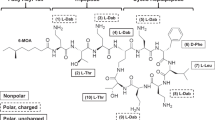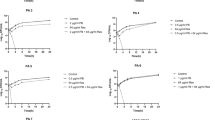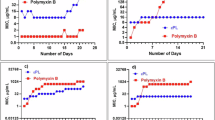Abstract
THE antibiotic polymyxin has been used with some success in the treatment of Pseudomonas æruginosa infections of burns1. Previous studies have shown that the addition of polymyxin to washed suspensions of this organism caused a release of pentose, phosphate and materials which had an absorption maxima at 260 mµ2,3. The leakage was a maximum in the presence of concentrations of polymyxin which killed 99 per cent of the cells, higher concentrations inhibiting the leakage.
This is a preview of subscription content, access via your institution
Access options
Subscribe to this journal
Receive 51 print issues and online access
$199.00 per year
only $3.90 per issue
Buy this article
- Purchase on SpringerLink
- Instant access to full article PDF
Prices may be subject to local taxes which are calculated during checkout
Similar content being viewed by others
References
Jackson, D. M., Lowbury, E. J. L., and Topley, E., Lancet, ii, 137 (1951).
Newton, B. A., J. Gen. Microbiol., 8, vi (1953).
Newton, B. A., J. Gen. Microbiol. (in the press).
Valko, E. I., and DuBois, A. S., J. Bact., 47, 15 (1944).
Bliss, E. A., Chandler, C. A., and Schoenbach, E. B., Ann. N.Y. Acad. Sci., 51, 944 (1949).
Few, A. V., and Schulman, J. H., Nature, 171, 644 (1953).
Author information
Authors and Affiliations
Rights and permissions
About this article
Cite this article
NEWTON, B. Reversal of the Antibacterial Activity of Polymyxin by Divalent Cations. Nature 172, 160–161 (1953). https://doi.org/10.1038/172160a0
Issue date:
DOI: https://doi.org/10.1038/172160a0
This article is cited by
-
Target site antimicrobial activity of colistin might be misestimated if tested in conventional growth media
European Journal of Clinical Microbiology & Infectious Diseases (2015)
-
Synergistic effects of Miconazole and Polymyxin B on microbial pathogens
Veterinary Research Communications (2009)
-
Morphological and physiological changes in bacterial cells treated with acrylamide
European Journal of Applied Microbiology and Biotechnology (1983)
-
Calcium and magnesium in Mueller-Hinton agar and their influence on disk diffusion susceptibility results
Current Microbiology (1979)
-
Antimicrobic diffusion susceptibility tests on a defined medium solidified with a synthetic polymer (neutra-gel)
Current Microbiology (1978)



